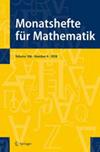保持同余函数的环。
IF 0.8
4区 数学
Q2 MATHEMATICS
Monatshefte fur Mathematik
Pub Date : 2018-01-01
Epub Date: 2017-11-08
DOI:10.1007/s00605-017-1105-3
引用次数: 2
摘要
设c0 (G)表示群G的同余保持函数的近环,研究了“c0 (G)何时为环”的问题。我们对外通过G的正规子群的晶格结构获得信息,对内通过G群的结构性质获得信息。本文章由计算机程序翻译,如有差异,请以英文原文为准。
Rings of congruence preserving functions.
Let denote the near-ring of congruence preserving functions of the group G. We investigate the question "When is a ring?". We obtain information externally via the lattice structure of the normal subgroups of G and internally via structural properties of the group G.
求助全文
通过发布文献求助,成功后即可免费获取论文全文。
去求助
来源期刊
CiteScore
1.60
自引率
11.10%
发文量
155
审稿时长
4-8 weeks
期刊介绍:
The journal was founded in 1890 by G. v. Escherich and E. Weyr as "Monatshefte für Mathematik und Physik" and appeared with this title until 1944. Continued from 1948 on as "Monatshefte für Mathematik", its managing editors were L. Gegenbauer, F. Mertens, W. Wirtinger, H. Hahn, Ph. Furtwängler, J. Radon, K. Mayrhofer, N. Hofreiter, H. Reiter, K. Sigmund, J. Cigler.
The journal is devoted to research in mathematics in its broadest sense. Over the years, it has attracted a remarkable cast of authors, ranging from G. Peano, and A. Tauber to P. Erdös and B. L. van der Waerden. The volumes of the Monatshefte contain historical achievements in analysis (L. Bieberbach, H. Hahn, E. Helly, R. Nevanlinna, J. Radon, F. Riesz, W. Wirtinger), topology (K. Menger, K. Kuratowski, L. Vietoris, K. Reidemeister), and number theory (F. Mertens, Ph. Furtwängler, E. Hlawka, E. Landau). It also published landmark contributions by physicists such as M. Planck and W. Heisenberg and by philosophers such as R. Carnap and F. Waismann. In particular, the journal played a seminal role in analyzing the foundations of mathematics (L. E. J. Brouwer, A. Tarski and K. Gödel).
The journal publishes research papers of general interest in all areas of mathematics. Surveys of significant developments in the fields of pure and applied mathematics and mathematical physics may be occasionally included.

 求助内容:
求助内容: 应助结果提醒方式:
应助结果提醒方式:


